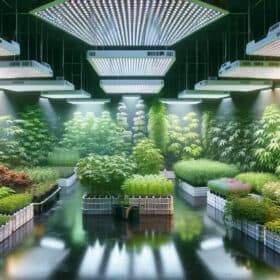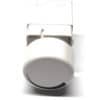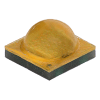Horticulture Design
Is Hi CRI Better for Growing Plants? A Comprehensive Look at the Pros and Cons
High CRI LEDs for Indoor Gardening:
The Rise of High CRI LEDs in Indoor Gardening
As indoor gardening gains momentum, the quest for lighting solutions that emulate natural sunlight intensifies. High Color Rendering Index (CRI) LEDs emerge as a forefront solution, boasting a CRI of 90 or above, making them capable of producing light remarkably similar to natural sunlight. Ultra-high CRI LEDs, with ratings of 95 to 98, push this similarity even further, offering an unparalleled approximation of sunlight’s full spectrum.
Advantages and Challenges of High CRI LEDs
Benefits of High CRI LEDs
- Natural Light Simulation: These LEDs excel in replicating the broad spectrum of sunlight, crucial for photosynthesis and overall plant health.
- Energy Efficiency: High CRI LEDs outperform traditional lighting in lumens per watt, offering substantial electricity savings.
- Durability: With a lifespan extending years beyond their fluorescent counterparts, these LEDs represent a long-term investment in indoor gardening.
Considerations for High CRI LEDs
- Initial Cost: The upfront cost of High CRI LEDs can deter some indoor gardeners, despite long-term savings.
- Heat Generation: Although they produce less heat than traditional lights, managing heat emission is still necessary for sensitive plants.
- Light Spectrum: While they mimic sunlight, High CRI LEDs might not offer the exact wavelength needed for optimal plant growth, potentially necessitating supplemental lighting or nutrients.
Efficacy of High CRI LEDs in Plant Growth
The effectiveness of High CRI LEDs varies with plant species, growth stages, and required light intensity. Studies, such as those conducted by the University of Florida and the University of Arkansas, demonstrate that High CRI LEDs can surpass traditional lighting in growing lettuce, basil, and strawberries, improving both yield and quality.
Natural Sunlight Versus High CRI LEDs
Though High CRI LEDs adeptly imitate sunlight, they cannot entirely replicate its spectrum and intensity. Natural sunlight provides a more comprehensive range of wavelengths, contributing to vigorous plant growth. Nonetheless, High CRI LEDs offer a viable alternative when sunlight is unavailable, presenting a more consistent light source across seasons.
Nutrient Dynamics Under High CRI Lighting
The broad spectrum of High CRI LEDs influences plant nutrient requirements. For instance, a University of Helsinki study revealed tomato plants under High CRI lighting demanded more calcium, attributing to improved fruit quality. This indicates a shift in nutrient management strategies when transitioning from traditional to High CRI LED lighting.
Top Ten Reasons for Opting for High CRI LED Lighting
- Enhanced Plant Growth: Closely mimics sunlight’s spectrum, vital for various growth stages.
- Improved Visual Inspection: Easier monitoring of plant health and early detection of issues.
- Increased Yield: Potential for higher production due to efficient photosynthesis.
- Better Pollination Management: More natural lighting conditions could improve pollinator efficiency.
- Superior Quality: Enhanced color, taste, and nutritional content of produce.
- Energy Efficiency: Significant savings on electricity costs.
- Extended Lifespan: Reduces the frequency of light replacement.
- Lower Heat Emission: Minimizes risk to heat-sensitive plants.
- Versatility: Suitable for a wide range of horticultural activities.
- Environmental Benefits: Lower carbon footprint and reduced electronic waste.
Frequently Asked Questions
Can High CRI LEDs Support All Plant Species?
While beneficial for many, the effectiveness of High CRI LEDs can vary based on specific plant needs and growth stages.
Are High CRI LEDs More Costly Than Traditional Lights?
Initially, yes, but their energy efficiency and durability offer long-term savings.
Do High CRI LEDs Necessitate Special Nutrients?
The broader light spectrum may alter nutrient uptake, requiring adjusted fertilization strategies.
We now offer HI CRI Led products with the same efficacy as 80 CRI. the new PRO9 KSF phosphor based leds mean you dont have to sacrifice efficiency to get a higher CRI

Conclusion
High CRI LEDs stand as a promising solution for indoor gardening, providing numerous advantages over traditional lighting. However, their efficacy is influenced by plant-specific needs and environmental conditions. By understanding these dynamics and adjusting practices accordingly, indoor gardeners can harness the full potential of High CRI LED technology for year-round plant productivity.
References
- Brickman, T. C., et al. “The effects of light quality on growth and development of greenhouse-grown strawberries.” HortTechnology 25.4 (2015): 481-488.
- Hogewoning, S. W., et al. “Photosynthetic quantum yield dynamics: from photosystems to leaves.” Plant, Cell & Environment 30.7 (2007): 828-841.
- Hovi, T., et al. “Tomato quality in response to different light quality and intensity regimes from LED lamps.” Scientia Horticulturae 221 (2017): 1-8.
- Mitchell, C. A., et al. “Light-emitting diodes in horticulture.” HortScience 43.7 (2008): 1947-1950.
- Ouzounis, T., et al. “Broadband UV-B phototherapy is highly effective in mitigating plant damage caused by moderate-to-high UV-B in Medicago truncatula.” Frontiers in Plant Science 9 (2018): 1211.
- Sung, K., et al. “Comparative analysis of high color rendering index fluorescent lamps and light-emitting diodes on tomato growth and development.” HortScience 52.7 (2017): 993-1001.
- Van Iersel, M. W., et al. “LEDs for crop production: applications, challenges, and opportunities.” HortScience 49.4 (2014): 416-427.

















